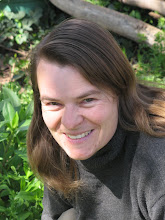I like playing with my bowls and plates, arranging them in different groupings or stacks. I’ve also noticed other people doing the same thing when they’ve been displayed in a setting without a “don’t touch” mindset (yes, risky, but ceramics are by nature tactile!). Sometimes the unglazed bowls are even more appealing in this sense, not having the visual complications of colour and shine.
Friday, September 24, 2010
Chun Blue
Chun Blue is one of the interesting but sometimes elusive glaze effects. The blue isn’t from any pigments in the glaze; it’s an “optical” colour, like the colours in a rainbow. The glaze forms tiny bubbles in the firing process that are the right size to refract blue light, but for this to happen, the glaze chemistry, firing conditions and glaze thickness all have to be right. If any of these are lacking the glaze comes out in the olive green seen in this photo where the glaze coat is thinner.
My Opalescent glazes also rely on light refraction for their colour, but in their case the refraction comes from tiny crystals that form as the glaze is cooling. Either fast cooling or reducing the amount of titanium (which encourages crystal formation) will result in the glaze being amber instead of the vibrant purples and blues.
My Opalescent glazes also rely on light refraction for their colour, but in their case the refraction comes from tiny crystals that form as the glaze is cooling. Either fast cooling or reducing the amount of titanium (which encourages crystal formation) will result in the glaze being amber instead of the vibrant purples and blues.
Hot & Cold
Our town doesn’t have mains gas, so I run the kiln using LP gas cylinders. On a cold and rainy night you can get the mind boggling contrast of freezing cylinder outside...
while inside things are well over the 1000 degree (Celsius) mark. The blue colour of the flame indicates that the kiln is oxygen starved (reducing) which is essential for the development of colour in my glazes, especially the celadon greens.
Thursday, September 16, 2010
Pyrochemistry!
I’ve often referred to ceramics as “pyrochemistry”- i.e. combining various minerals, either in a purified, pre-processed form, or in the less predictable but somehow fascinating form of natural clays, rocks and ashes, and then subjecting them to extreme heat in the kiln to combine them and permanently alter their molecular structure. I’m constantly entranced by the transformation of various dusty looking brown or grey glazes into smooth glassy surfaces of varied colours with no resemblance at all to their original state.
Subscribe to:
Posts (Atom)







